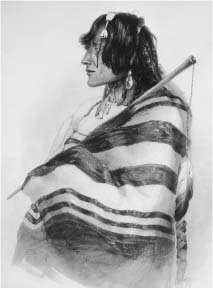

The massacre of Piegan Blackfeet in their winter camp on the Marias River, in what is now Montana, in January of 1870 is unique among the massacres considered in this book.
Why? Because this large band of Blackfeet were dying anyway: of smallpox, at the rate of six or seven per day.
It is not likely that Colonel E. M. Baker, who lead the assault on the Blackfeet camp, knew that the tribe was infected when he set out to eliminate them as a raiding force, but he found out soon enough and went right on with the killing; at the end of the day the army claimed to have killed 173 Indians, a big total.
What was odd about it—apart from the circumstance that the army chose to kill Indians who were dying already—is that the army claimed to have killed 120 warriors, a proportion of warriors to women and children not seen in any other massacre. J. P. Dunn throws up many statistics in order to suggest that the army’s count couldn’t have been right. There were always, in his view, more women and and children to be found in a camp than men.
Well, if they don’t have smallpox, maybe. The 120 warriors might well have been in camp because they were too sick to be anywhere else.
But if they were that sick, why bother to kill them?
Because they were Blackfeet—probably the most feared of all Western tribes—that’s why.
When Captains Meriwether Lewis and William Clark made their great trek across America and back in 1804–1806 they encountered many Indians, some of them ill-disposed toward the Corps of Discovery; but they got all the way to the Western Ocean without killing a single native, a high tribute to the care they took to get on with the local tribes.
On the return journey they were not quite so lucky. While Captain Lewis and some of the Corps were exploring the Marias River country, not too far from where the 1870 massacre would occur, they traveled for a while with some Piegan Blackfeet, although the Piegans were well known to be brazen thieves.
Sure enough, one morning, a Piegan boldly seized a rifle and attempted to make off with it. The attempt didn’t work and, in the struggle over the gun, the Piegan was stabbed to death. Another Piegan fired at Captain Lewis, who shot back, wounding him. Whether he died is debated. The Corps proceeded home; there was no more trouble with Indians—the stabbed Piegan was the only sure kill on the whole amazing journey.
The Blackfeet country is in northwestern Montana and some of Idaho. No group of Indians was more determined to keep whites out of their lands. As early as 1731, when the great Canadian explorer La Verendrye tried to cross from what is now South Dakota to the Western Ocean it was most probably the Blackfeet who turned him back. Travel in the Blackfeet country, from the Yellowstone over to the Columbia, was just not safe.
Indeed, one of the famous episodes in the history of the American fur trade involved the militant Blackfeet. On their way back down the Missouri in 1806 the captains met two intrepid traders who were resolutely setting out to trap in the High West. This intrigued young John Colter, a member of the Corps. He was given permission by the captains to go back upriver and try to keep his hair while he sought his fortune.
John Colter did keep his hair, but, upon encountering some Blackfeet, two of his companions were not so lucky. They were killed, but the Blackfeet must have been feeling sporting, because they gave Colter a chance. He was stripped naked and told to run. The Blackfeet allowed him a decent start and then set out in pursuit.
John Colter could run. With his life on the line he ran so hard that blood gushed out of his nose. Even so, one fast-running warrior was closing in on him, spear at the ready. Colter whirled suddenly, taking the warrior by surprise. He wrested the warrior’s spear away and killed him with it.
Then he ran some more, finally eluding his captor pursuers by slipping into an icy pond and hiding under a beaver dam.
The annoyed Blackfeet finally gave up.
Naked, Colter walked out, through a land of geysers. The likelihood is that he discovered Yellowstone.
The Blackfeet were a handsome people. The first painters who managed to get upriver, to Fort Union or Fort McKenzie, loved to do their portraits and have left us some fine ones.
The painters were the American George Catlin and the Swiss Karl Bodmer. Some of the portraits they did on the upper Missouri between 1832 and 1834 are among the finest examples of Western art.
The relevance of all this to the massacre of the dying Piegans in 1870 is that the militancy of the Blackfeet was well known and widely respected. That particular part of Montana is thinly populated even today, in part because of Blackfeet resistance.
Thus when Colonel Baker arrived at the Blackfeet encampment that morning he killed the raiders he had come to kill. Many of them no doubt would have died, but Colonel Baker was not disposed to leave it to chance, his reasoning perhaps being that those who managed to recover would soon be able to be troublesome again.
When Blackfeet were involved, the U.S. Army would rather be safe than sorry. They had come to kill, and they killed.

Kiäsax, Piegan Blackfeet Man
Karl Bodmer (Swiss, 1809–1893)
Watercolor on paper